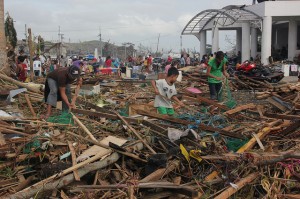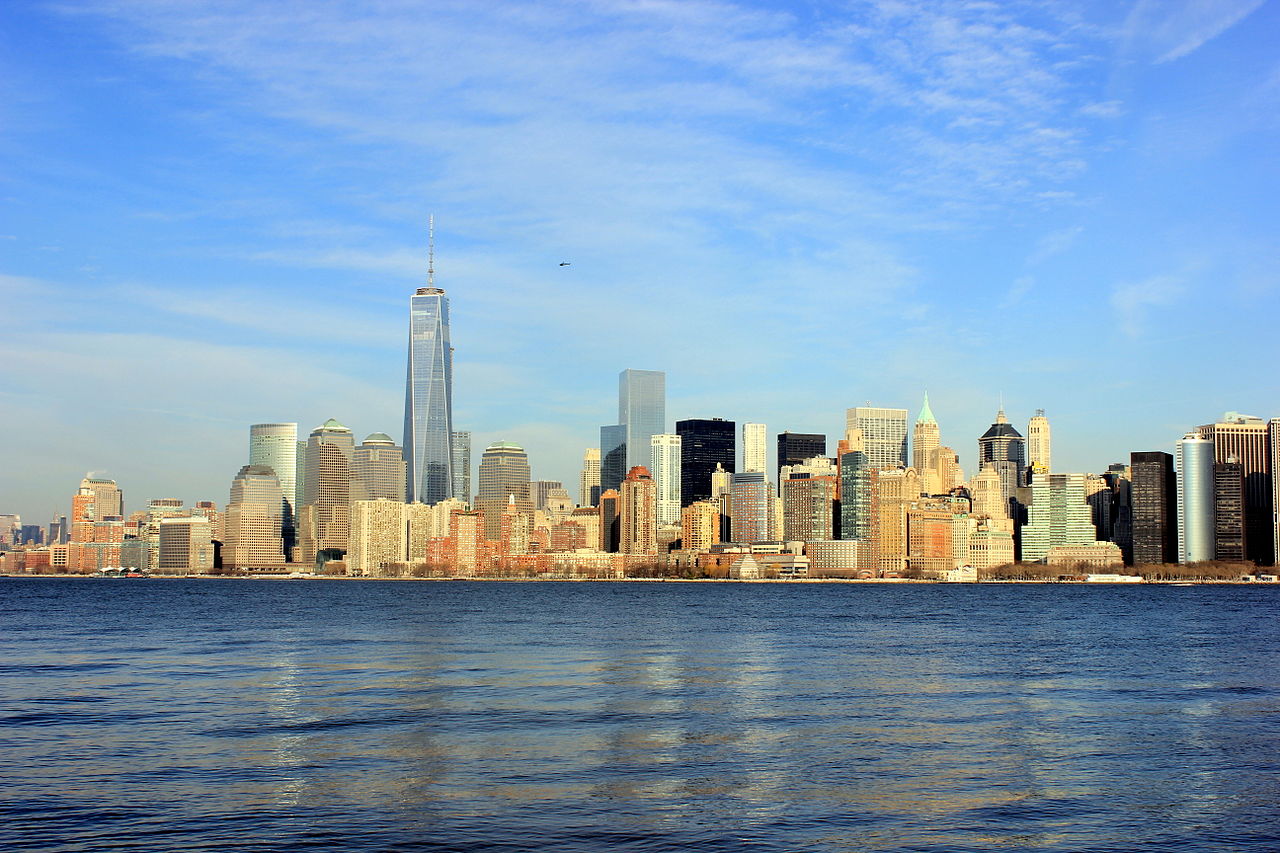Meredith Wilensky, Associate Director & Fellow Columbia Center for Climate Change Law
Just three days before the 19th Conference of the Parties (COP) to the UNFCCC was set to begin in Warsaw, Poland, Typhoon Haiyan hit the eastern provinces of the Philippines killing as many as 10,000 people and displacing over 600,000. With winds up to 200 mph (378 km/h), “Super Typhoon” Haiyan has been estimated to be one of the strongest storms of its type in recorded history.1
At the opening of the Warsaw COP, Yeb Sano, the head of the Philippines climate delegation reportedly brought tears to the eyes of other delegates when he discussed the devastation caused by Haiyan and the contribution of climate change to extreme weather events. Sano challenged negotiators to heed the impacts of climate change on communities around the world:
To anyone who continues to deny the reality that is climate change, I dare you to get off your ivory tower and away from the comfort of your armchair. I dare you to go to the islands of the Pacific, the islands of the Caribbean and the islands of the Indian Ocean and see the impacts of rising sea levels… to the vast savannas of Africa where climate change has likewise become a matter of life and death as food and water becomes scarce. Not to forget the massive hurricanes in the Gulf of Mexico and the eastern seaboard of North America. And if that is not enough, you may want to pay a visit to the Philippines right now.
Sano called attention to the need to develop an international mechanism to address loss and damage from climate change. Calling the climate crisis “madness,” he urged delegates to take drastic and meaningful action at this year’s COP. Sano finished with an unscripted pledge to fast during the negotiations until a meaningful outcome is in sight that includes a loss and damage mechanism.
Sano’s remarks put a human face on an issue that is largely clouded by statistics and complex science. It also highlights the reality that climate change negotiations today are as much about dealing with the impacts of climate change as preventing further emissions.
Linking Extreme Weather Events with Climate Change
It is important to note that Sano did not state that climate change caused Typhoon Haiyan. Instead, he pointed to the Fifth IPCC report’s finding that warming of the atmosphere is already contributing to increased risks from extreme weather events.2 With respect to typhoons, he explained that the warming of the oceans increases the intensity of typhoons leading to more destructive storms. (While the science of impacts on cyclones is less confident than for some other extreme weather events, current models demonstrate that although the number of tropical cyclones could decrease or remain unchanged as a result of climate change, their average intensity is likely to increase.3)
This distinction is important. Linking specific events to climate change is problematic, because weather events are a result of a number of factors, and warming of the climate system is only one. The best analogy I’ve seen compares greenhouse gases to steroids in baseball, pointing out that viewers do not typically ask whether any specific home run was caused by steroid use. Nevertheless, a baseball player’s overall homerun stats at the end of the season might well suggest that he had engaged in steroid use, thereby increasing the likelihood of each home run he hit. Increased levels of greenhouse gasses in the atmosphere, like steroids, change the baseline of the system and increase the chances of extreme weather events. Thus, while climate change may have made the intensity of Haiyan more likely, we cannot say it was caused by climate change.
Scientists have begun using statistical analysis to assess how anthropogenic emissions of greenhouse gases make an event more likely.4 However, attribution of risk still cannot determine precise magnitude of contribution. At best, it only provides a range of how much more likely the specific event was to occur.
Addressing loss and damage caused by climate change
While attributing any specific event to climate change poses issues, it is well accepted that climate change is already resulting in real impacts with serious economic implications. Following Sano’s powerful plea, three groups representing over half of the countries involved in the negotiations at Warsaw issued a call for immediate talks on the development of a loss and damage mechanism.5 A loss and damage mechanism is intended to assist countries (usually developing countries with relatively low emissions) that are particularly vulnerable to the adverse effects of climate change in managing the climate-related damages that occur despite their efforts to adapt. Addressing loss and damage could include risk management and prevention tools, risk transfer programs such as insurance, and rehabilitation and compensation mechanisms.
Loss and damage has emerged as an increasingly important issue as it has become clear that efforts to mitigate climate change have been insufficient to avoid all impacts.6 Loss and damage began to really pick up steam in international negotiations at COP 13 in Bali in 2007. The Bali Action Plan calls for “enhanced action on adaptation, including…disaster risk reduction strategies and means to address loss and damage.”7 At COP 16 in Cancun, the parties established a working programme to assess approaches to address loss and damage. The work programme addresses three thematic areas: assessing the risk of loss and damage; approaches to address loss and damage; and the role of the Convention in enhancing implementation of approaches to address loss and damage.
Efforts to address loss and damage under the UNFCCC have faced substantial pushback from developed nations, who are concerned about facing huge financial liabilities as a result of historical emissions.8 Despite opposition, at COP 18 in Doha, negotiators agreed that the Convention’s approach to loss and damage should include finance, technology, and capacity building, among other things. Negotiators also agreed to establish institutional arrangements to address loss and damage under the Convention at this year’s COP in Warsaw.
In Warsaw, parties have begun substantive negotiations on loss and damage. As expected, the block of less developed countries known as the G77 and China are promoting a dedicated international mechanism under the UNFCCC, while developed nations have called for consideration of responses within and outside the UNFCCC, since responses outside the UNFCC are voluntary and largely avoid liability concerns. The outcome of these negotiations is particularly important because the G77 + China have emphasized the importance of including a loss and damage component in a 2015 agreement. Failure to address institutional arrangements during current negotiations would reduce confidence in the ability to reach an agreement in 2015.
The devastation of Typhoon Haiyan highlights the need for international support in the wake of extreme weather events. However, it also demonstrates some of the issues with loss and damage as a concept, such as uncertainty in attributing specific weather events to climate change, how to apportion responsibility, and what financial and nonfinancial mechanisms are appropriate. What is clear is that loss and damage is no longer a sideline issue in climate negotiations. This increased focus suggests that reaching a meaningful agreement in 2015 will require negotiators to grapple with these difficult questions.
A full transcript of Yeb Sano’s remarks is available here and a video is available here.
Photo credit: Nove foto da Firenze
- As it happened: Typhoon Haiyan hits Philippines BBC, https://www.bbc.co.uk/news/world-asia-24863480. [↩]
- IPCC, The Physical Science Basis: Summary for Policy Makers 3 (2013), https://www.climatechange2013.org/images/uploads/WGI_AR5_SPM_brochure.pdf. [↩]
- IPCC, Climate Phenomena and their Relevance for Future Regional Climate Change 29 (2013), www.climatechange2013.org/images/uploads/WGIAR5_WGI-12Doc2b_FinalDraft_Chapter14.pdf. [↩]
- Pardeep Pall, Anthropogenic greenhouse gas contribution to flood risk in England and Wales in autumn 2000 470 Nature 382, https://www.nature.com/nature/journal/v470/n7334/full/nature09762.html. [↩]
- Typhoon Haiyan sends loss and damage roaring up UN climate summit agenda RTCC (Nov. 11. 2013), https://www.rtcc.org/2013/11/11/typhoon-haiyan-sends-loss-and-damage-roaring-up-un-climate-summit-agenda/#sthash.j4ZUo5Ri.dpuf. [↩]
- Koko Warner & Sumaya Zakieldeen, Loss and Damage Due to Climate Change: An Overview of the UNFCCC Negotiations, European Capacity Building Initiative 3 (2011). [↩]
- Bali Action Plan, Para. 1(c) (2007). [↩]
- Megan Rowling, Warsaw climate talks expected to deliver loss and damage mechanism, Reuters (Nov. 7, 2013) https://sustainability.thomsonreuters.com/2013/11/07/warsaw-climate-talks-expected-deliver-loss-damage-mechanism/. [↩]



